brake light TOYOTA COROLLA HATCHBACK 2023 Owners Manual
[x] Cancel search | Manufacturer: TOYOTA, Model Year: 2023, Model line: COROLLA HATCHBACK, Model: TOYOTA COROLLA HATCHBACK 2023Pages: 436, PDF Size: 8.72 MB
Page 2 of 436
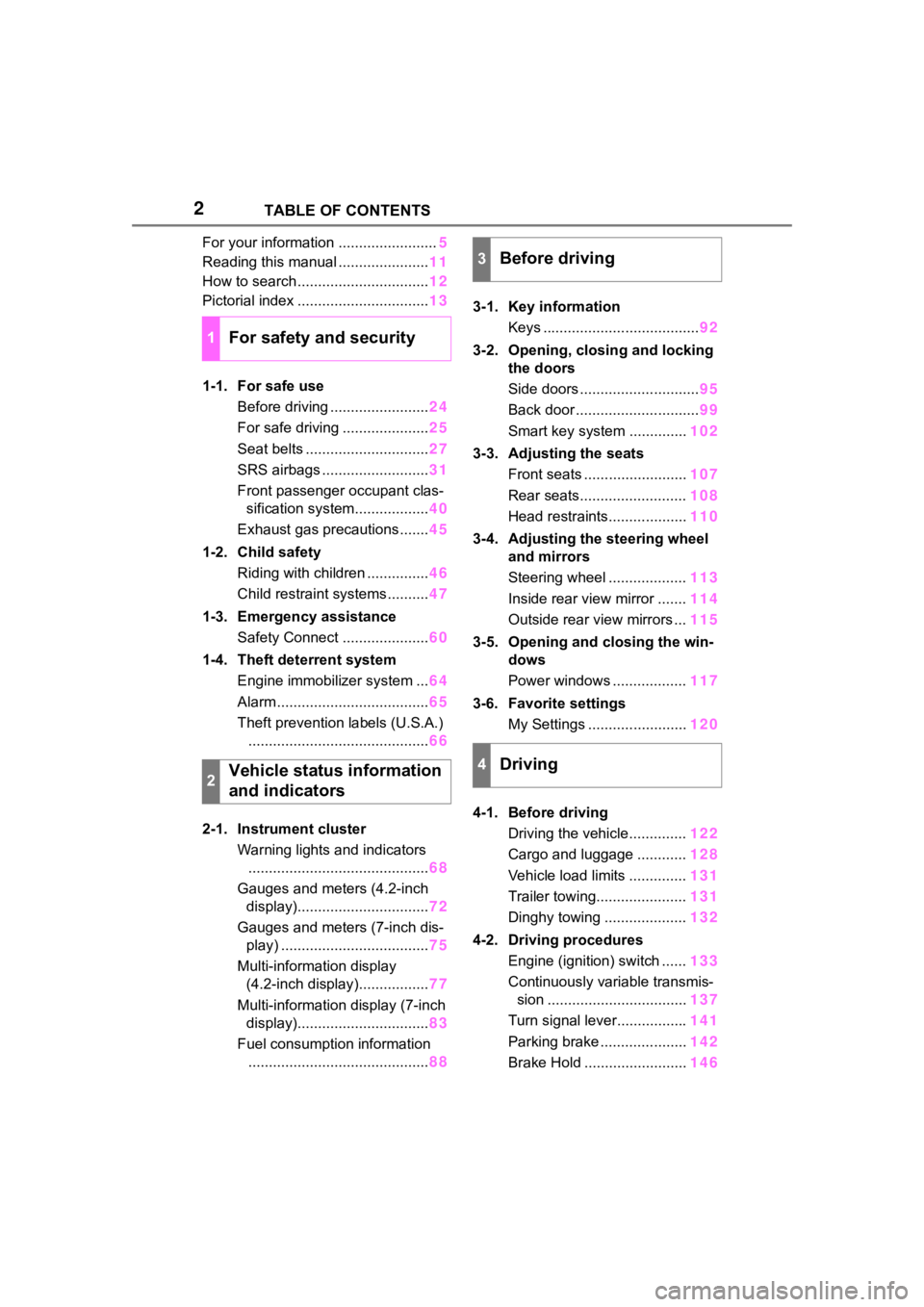
2TABLE OF CONTENTS
For your information ........................5
Reading this manual ...................... 11
How to search ................................ 12
Pictorial index ................................ 13
1-1. For safe use Before driving ........................ 24
For safe driving ..................... 25
Seat belts .............................. 27
SRS airbags .......................... 31
Front passenger occupant clas- sification system.................. 40
Exhaust gas precautions....... 45
1-2. Child safety Riding with children ............... 46
Child restraint systems .......... 47
1-3. Emergency assistance Safety Connect ..................... 60
1-4. Theft deterrent system Engine immobilizer system ... 64
Alarm ..................................... 65
Theft prevention labels (U.S.A.) ............................................ 66
2-1. Instrument cluster Warning lights and indicators............................................ 68
Gauges and meters (4.2-inch display)................................ 72
Gauges and meters (7-inch dis- play) .................................... 75
Multi-information display (4.2-inch display)................. 77
Multi-information display (7-inch display)................................ 83
Fuel consumption information ............................................ 883-1. Key information
Keys ...................................... 92
3-2. Opening, closing and locking the doors
Side doors ............................. 95
Back door .............................. 99
Smart key system .............. 102
3-3. Adjusting the seats Front seats ......................... 107
Rear seats.......................... 108
Head restraints................... 110
3-4. Adjusting the steering wheel and mirrors
Steering wheel ................... 113
Inside rear view mirror ....... 114
Outside rear view mirrors ... 115
3-5. Opening and closing the win- dows
Power windows .................. 117
3-6. Favorite settings My Settings ........................ 120
4-1. Before driving Driving the vehicle.............. 122
Cargo and luggage ............ 128
Vehicle load limits .............. 131
Trailer towing...................... 131
Dinghy towing .................... 132
4-2. Driving procedures Engine
(ignition) switch ...... 133
Continuously variable transmis- sion .................................. 137
Turn signal lever................. 141
Parking brake ..................... 142
Brake Hold ......................... 146
1For safety and security
2Vehicle status information
and indicators
3Before driving
4Driving
Page 33 of 436

331-1. For safe use
1
For safety and security
Front impact sensors
Airbag sensor assembly
Your vehicle is equipped with ADVANCED AIRBAGS designed
based on the US motor vehicle safety standards (FMVSS208). The
airbag sensor assembly (ECU) cont rols airbag deployment based on
information obtained from the sensors etc. shown in the system
components diagram above. This in formation includes crash sever-
ity and occupant information. As the airbags deploy, a chemical
reaction in the inflators quickly fills the airbags with non-toxic gas to
help restrain the motion of the occupants.
■If the SRS airbags deploy
(inflate)
●Slight abrasions, burns, bruising
etc., may be sustained from SRS
airbags, due to the extremely high
speed deployment (inflation) by
hot gases.
●A loud noise and white powder will
be emitted.
●Parts of the airbag module (steer-
ing wheel hub, airbag cover and
inflator) as well as the front seats,
parts of the front and rear pillars,
and roof side rails, may be hot for
several minutes. T he airbag itself
may also be hot.
●The windshield may crack.
●The brakes and st op lights will be
controlled automatically. ( P.226)
●The interior lights will turn on auto-
matically. ( P.243)
●The emergency flashers will turn
on automatically. ( P.312)
●Fuel supply to the engine will be
stopped. (P.319)
●For Safety Connect subscribers, if
any of the followin g situations
occur, the system is designed to
send an emergency call to the
response center, notifying them of
the vehicle’s location (without
needing to push the “SOS” button)
and an agent will attempt to speak
with the occupants to ascertain the level of emergency and assis-
tance required. If the occupants
are unable to communicate, the
agent automatically treats the call
as an emergency and helps to dis-
patch the necessary emergency
services. (
P. 6 0 )
• An SRS airbag is deployed.
• A seat belt pretensioner is acti- vated.
• The vehicle is involved in a severe rear-end collision.
■SRS airbag deployment condi-
tions (SRS front airbags)
●The SRS front airbags will deploy
in the event of an impact that
exceeds the set threshold level
(the level of forc e corresponding
to an approximately 12 - 18 mph
[20 - 30 km/h] frontal collision with
a fixed wall that does not move or
deform).
However, this threshold velocity will
be considerably higher in the follow-
ing situations:
• If the vehicle strikes an object, such as a parked vehicle or sign
pole, which can move or deform
on impact
• If the vehicle is involved in an underride collision, such as a colli-
sion in which the front of the vehi-
cle “underrides”, or goes under,
the bed of a truck
●Depending on the type of collision,
it is possible that only the seat belt
pretensioners will activate.
Page 69 of 436
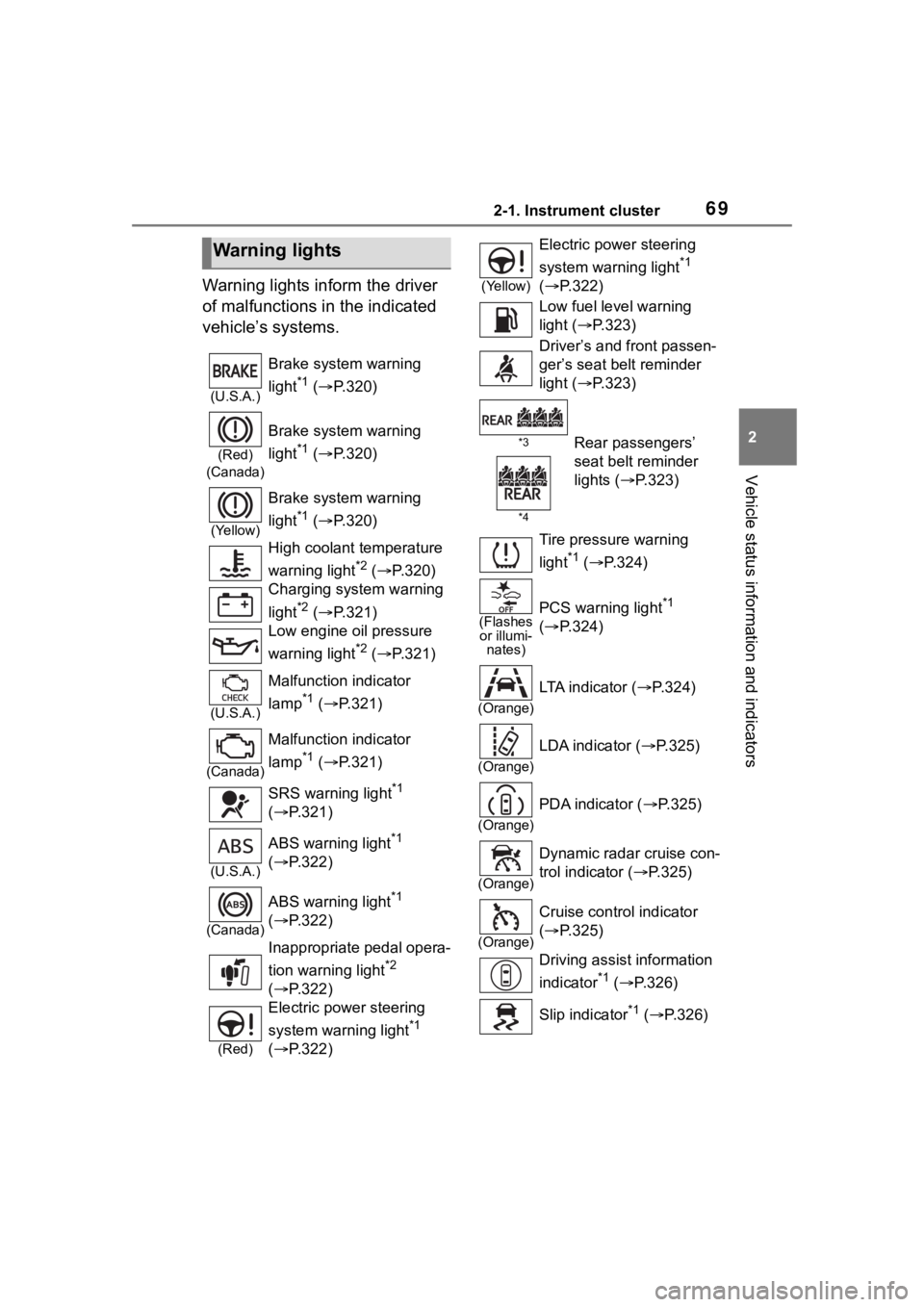
692-1. Instrument cluster
2
Vehicle status information and indicators
Warning lights inform the driver
of malfunctions in the indicated
vehicle’s systems.
Warning lights
(U.S.A.)
Brake system warning
light
*1 ( P.320)
(Red)
(Canada)
Brake system warning
light
*1 ( P.320)
(Yellow)
Brake system warning
light
*1 ( P.320)
High coolant temperature
warning light
*2 ( P.320)
Charging system warning
light
*2 ( P.321)
Low engine oil pressure
warning light
*2 ( P.321)
(U.S.A.)
Malfunction indicator
lamp
*1 ( P.321)
(Canada)
Malfunction indicator
lamp
*1 ( P.321)
SRS warning light
*1
( P.321)
(U.S.A.)
ABS warning light*1
( P.322)
(Canada)
ABS warning light*1
( P.322)
Inappropriate pedal opera-
tion warning light
*2
( P.322)
(Red)
Electric power steering
system warning light
*1
( P.322)
(Yellow)
Electric power steering
system warning light
*1
( P.322)
Low fuel level warning
light ( P.323)
Driver’s and front passen-
ger’s seat belt reminder
light ( P.323)
*3
*4Rear passengers’
seat belt reminder
lights ( P.323)
Tire pressure warning
light
*1 ( P.324)
(Flashes
or illumi- nates)PCS warning light*1
( P.324)
(Orange)
LTA indicator ( P.324)
(Orange)
LDA indicator ( P.325)
(Orange)
PDA indicator (P.325)
(Orange)
Dynamic radar cruise con-
trol indicator ( P.325)
(Orange)
Cruise control indicator
( P.325)
Driving assist information
indicator
*1 ( P.326)
Slip indicator
*1 ( P.326)
Page 70 of 436
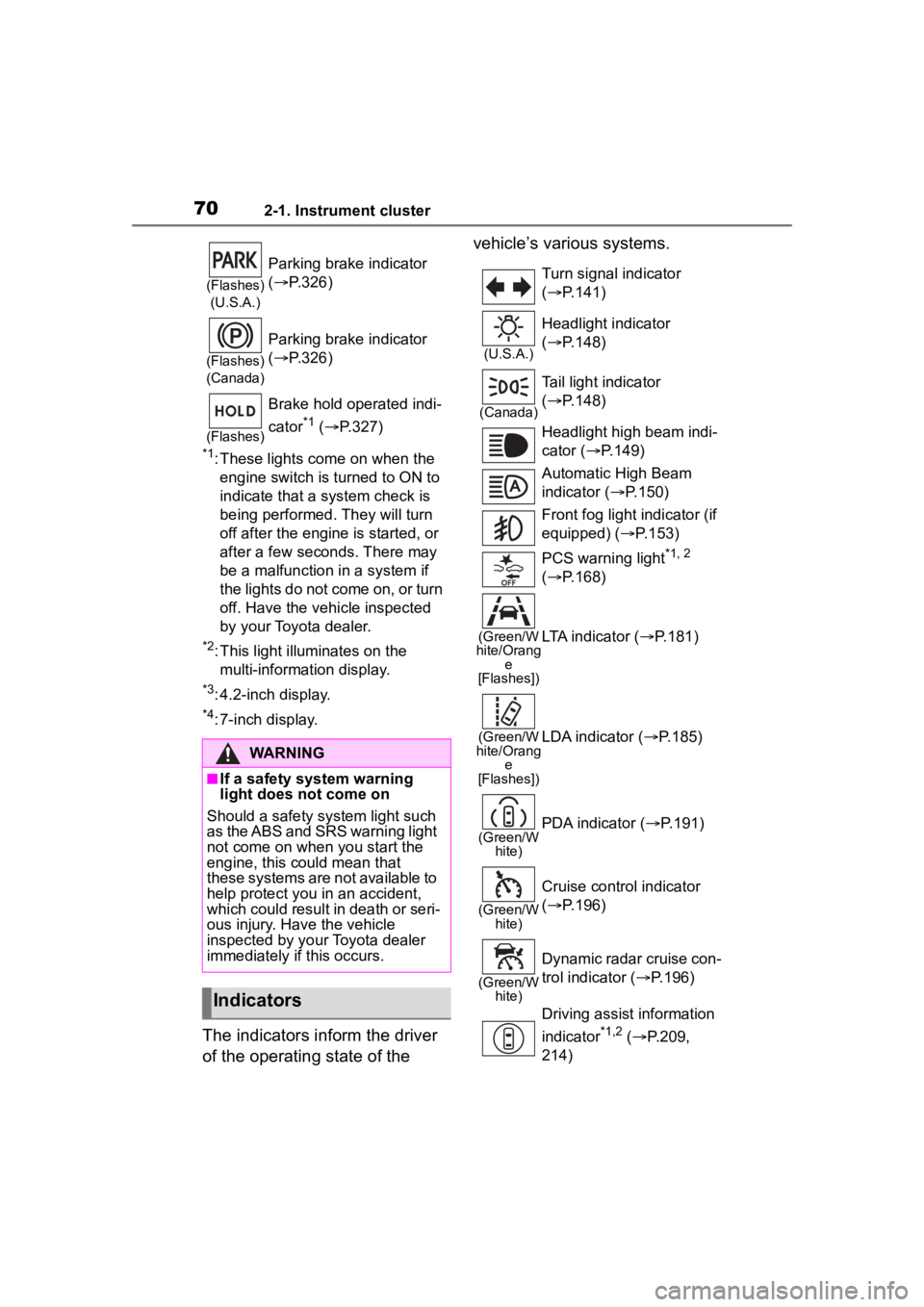
702-1. Instrument cluster
*1: These lights come on when the engine switch is turned to ON to
indicate that a system check is
being performed. They will turn
off after the engine is started, or
after a few seconds. There may
be a malfunction in a system if
the lights do not come on, or turn
off. Have the vehicle inspected
by your Toyota dealer.
*2: This light illuminates on the multi-information display.
*3: 4.2-inch display.
*4: 7-inch display.
The indicators inform the driver
of the operating state of the vehicle’s various systems.
(Flashes)
(U.S.A.)
Parking brake indicator
( P.326)
(Flashes)
(Canada)
Parking brake indicator
( P.326)
(Flashes)
Brake hold operated indi-
cator
*1 ( P.327)
WARNING
■If a safety system warning
light does not come on
Should a safety system light such
as the ABS and SRS warning light
not come on when you start the
engine, this could mean that
these systems are not available to
help protect you in an accident,
which could result in death or seri-
ous injury. Have the vehicle
inspected by your Toyota dealer
immediately if this occurs.
Indicators
Turn signal indicator
( P.141)
(U.S.A.)
Headlight indicator
( P.148)
(Canada)
Tail light indicator
( P.148)
Headlight high beam indi-
cator ( P.149)
Automatic High Beam
indicator ( P.150)
Front fog light indicator (if
equipped) ( P.153)
PCS warning light
*1, 2
( P.168)
(Green/W
hite/Orang e
[Flashes])LTA indicator ( P.181)
(Green/W
hite/Orang e
[Flashes])LDA indicator ( P.185)
(Green/W
hite)PDA indicator ( P.191)
(Green/W
hite)
Cruise control indicator
( P.196)
(Green/W
hite)
Dynamic radar cruise con-
trol indicator ( P.196)
Driving assist information
indicator
*1,2 ( P.209,
214)
Page 71 of 436
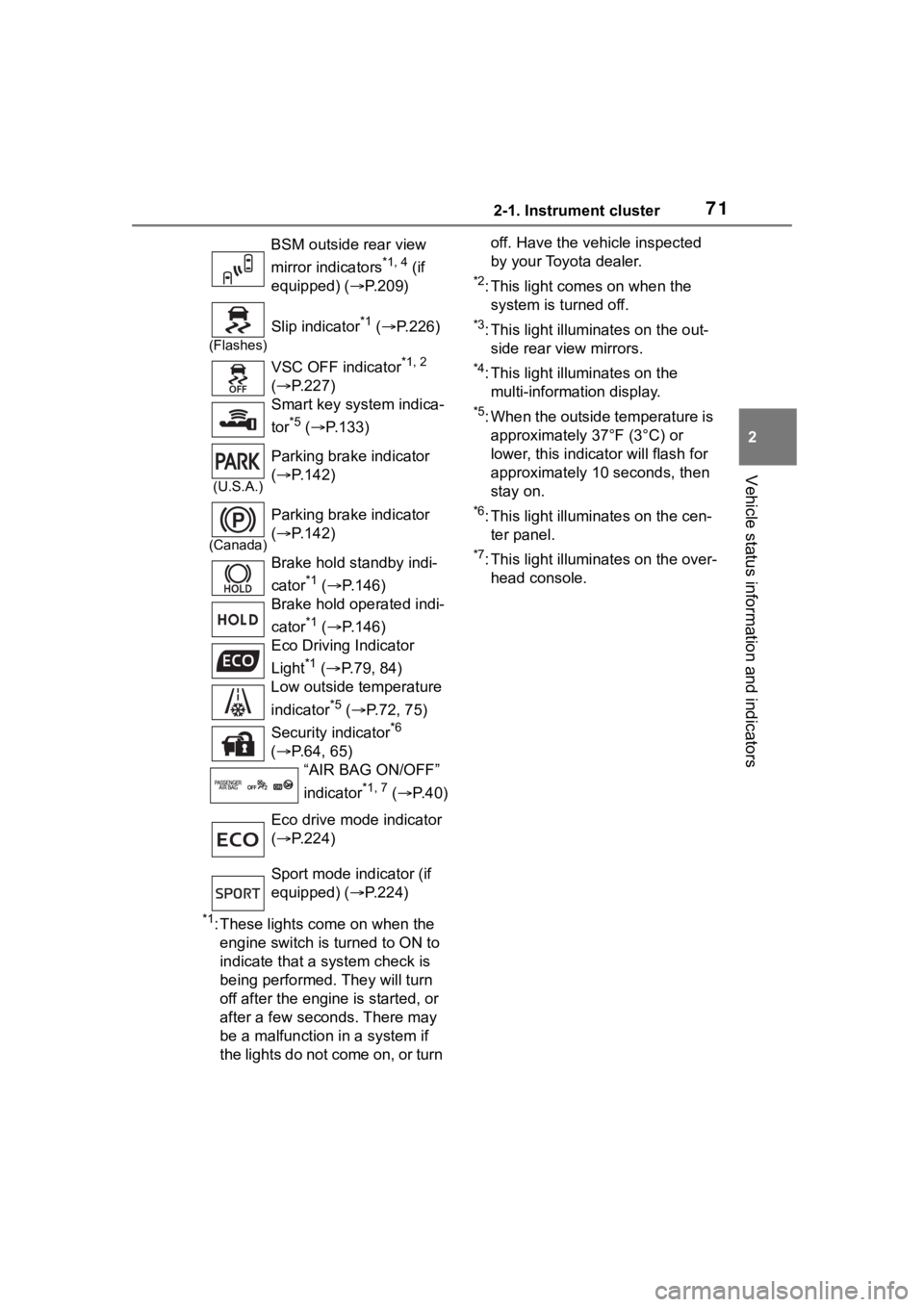
712-1. Instrument cluster
2
Vehicle status information and indicators
*1: These lights come on when the engine switch is turned to ON to
indicate that a system check is
being performed. They will turn
off after the engine is started, or
after a few seconds. There may
be a malfunction in a system if
the lights do not come on, or turn off. Have the vehicle inspected
by your Toyota dealer.
*2: This light comes on when the
system is turned off.
*3: This light illuminates on the out-side rear view mirrors.
*4: This light illuminates on the multi-information display.
*5: When the outside temperature is approximately 37°F (3°C) or
lower, this indicator will flash for
approximately 10 seconds, then
stay on.
*6: This light illuminates on the cen-ter panel.
*7: This light illuminates on the over-head console.
BSM outside rear view
mirror indicators
*1, 4 (if
equipped) ( P.209)
(Flashes)
Slip indicator*1 ( P.226)
VSC OFF indicator
*1, 2
( P.227)
Smart key system indica-
tor
*5 ( P.133)
(U.S.A.)
Parking brake indicator
( P.142)
(Canada)
Parking brake indicator
( P.142)
Brake hold standby indi-
cator
*1 ( P.146)
Brake hold operated indi-
cator
*1 ( P.146)
Eco Driving Indicator
Light
*1 ( P.79, 84)
Low outside temperature
indicator
*5 ( P.72, 75)
Security indicator
*6
( P.64, 65)
“AIR BAG ON/OFF”
indicator
*1, 7 ( P. 4 0 )
Eco drive mode indicator
( P.224)
Sport mode indicator (if
equipped) ( P.224)
Page 109 of 436
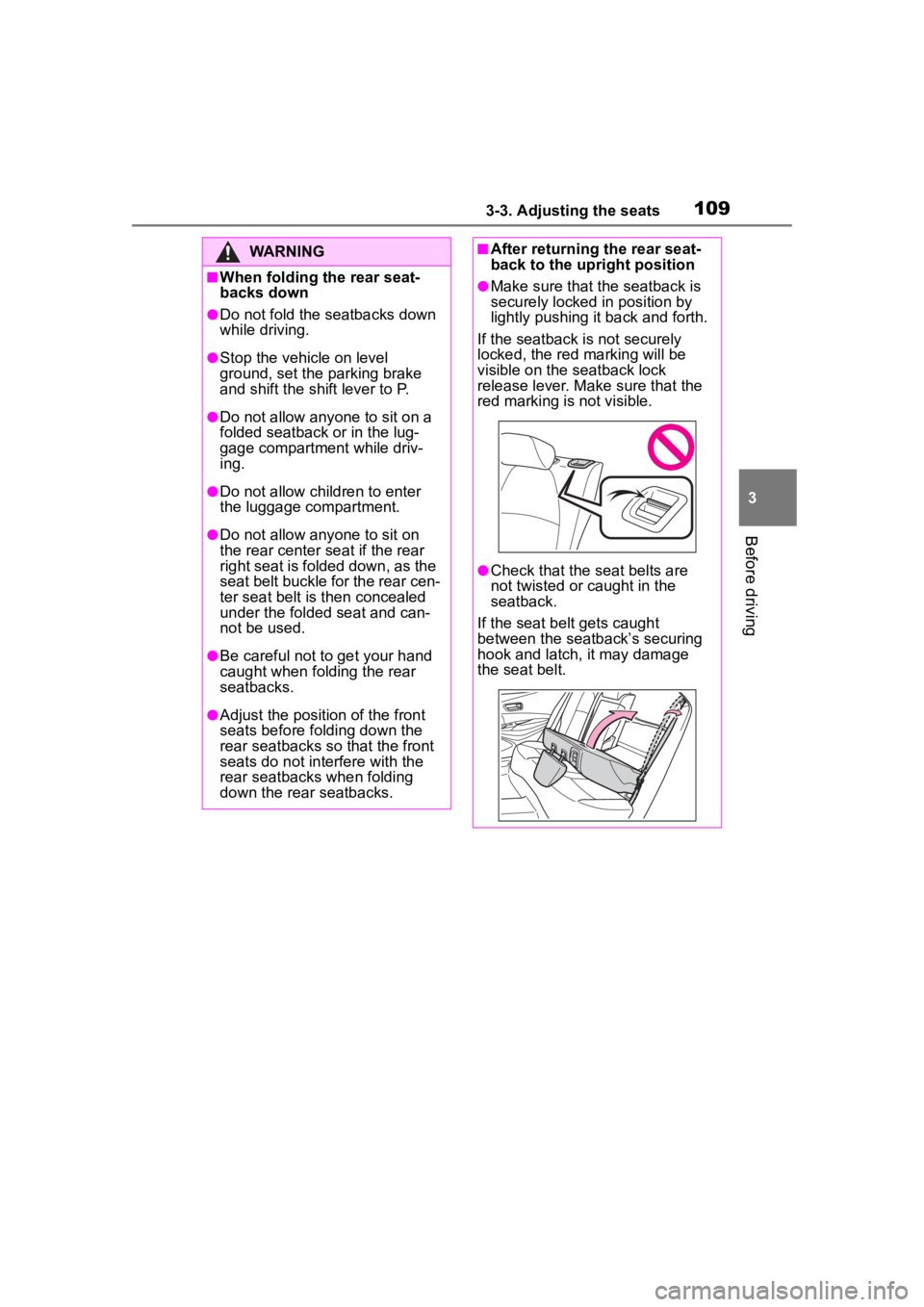
1093-3. Adjusting the seats
3
Before driving
WARNING
■When folding the rear seat-
backs down
●Do not fold the seatbacks down
while driving.
●Stop the vehicle on level
ground, set the parking brake
and shift the shift lever to P.
●Do not allow anyone to sit on a
folded seatback or in the lug-
gage compartment while driv-
ing.
●Do not allow child ren to enter
the luggage compartment.
●Do not allow any one to sit on
the rear center seat if the rear
right seat is folded down, as the
seat belt buckle for the rear cen-
ter seat belt is then concealed
under the folded seat and can-
not be used.
●Be careful not to get your hand
caught when folding the rear
seatbacks.
●Adjust the position of the front
seats before folding down the
rear seatbacks so that the front
seats do not interfere with the
rear seatbacks when folding
down the rear seatbacks.
■After returning the rear seat-
back to the upright position
●Make sure that the seatback is
securely locked in position by
lightly pushing it back and forth.
If the seatback is not securely
locked, the red marking will be
visible on the seatback lock
release lever. Make sure that the
red marking is not visible.
●Check that the seat belts are
not twisted or caught in the
seatback.
If the seat belt gets caught
between the seatback’s securing
hook and latch, it may damage
the seat belt.
Page 121 of 436

121
4
4
Driving
Driving
.4-1. Before drivingDriving the vehicle....... 122
Cargo and luggage ..... 128
Vehicle load limits ....... 131
Trailer towing............... 131
Dinghy towing ............. 132
4-2. Driving procedures Engine (ignition) switch.................................. 133
Continuously variable trans- mission ...................... 137
Turn signal lever.......... 141
Parking brake .............. 142
Brake Hold .................. 146
4-3. Operating the lights and wipers
Headlight switch .......... 148
AHB (Automatic High Beam)........................ 150
Fog light switch ........... 153
Windshield wipers and washer....................... 154
Rear window wiper and washer....................... 155
4-4. Refueling Opening the fuel tank cap.................................. 157
4-5. Using the driving support
systems
Toyota Safety Sense 3.0 software update......... 159Toyota Safety Sense 3.0
.................................. 161
PCS (Pre-Collision System) .................................. 167
LTA (Lane Tracing Assist) .................................. 177
LDA (Lane Departure Alert) .................................. 182
PDA (Proactive driving assist) ........................ 187
Dynamic radar cruise con- trol ............................. 193
Cruise control .............. 201
Emergency Driving Stop System ...................... 204
RSA (Road Sign Assist) .................................. 206
BSM (Blind Spot Monitor) .................................. 209
RCTA (Rear Cross Traffic Alert) function ............ 214
Safe Exit Assist ........... 219
Driving mode select switch .................................. 224
Driving assist systems .................................. 225
4-6. Driving tips Winter driving tips........ 230
Page 122 of 436

1224-1. Before driving
4-1.Before driving
■Starting the engine
P. 1 3 3
■Driving
1 With the brake pedal
depressed, shift the shift
lever to D. ( P.137)
2 Release the parking brake.
( P.142)
If the parking brake is in automatic
mode, the parkin g brake will be
released automatically. ( P.142)
3 Gradually release the brake
pedal and gently depress the
accelerator pedal to acceler-
ate the vehicle.
■Stopping
1 With the shift lever in D,
depress the brake pedal.
2 If necessary, set the parking
brake. ( P.142)
If the vehicle is to be stopped for an
extended period of time, shift the
shift lever to P. ( P.137)
■Parking the vehicle
1 With the shift lever in D,
depress the brake pedal to
stop the vehicle completely.
2 Set the parking brake
( P.142), and shift the shift
lever to P. ( P.137)
Make sure the park ing brake indi-
cator light is on.
3 Press the engine switch to
stop the engine.
4 Slowly release the brake
pedal.
5 Lock the door, making sure
that you have the key on your
person.
If parking on a hill, block the wheels
as needed.
■Starting off on a steep
uphill
1 Make sure that the parking
brake is set and shift the shift
lever to D.
2 Gently depress the accelera-
tor pedal.
3 Release the parking brake.
■Driving in the rain
●Drive carefully whe n it is raining,
because visibility will be reduced,
the windows may become
fogged-up, and the road will be
slippery.
●Drive carefully whe n it starts to
rain, because the road surface will
be especially slippery.
●Refrain from hig h speeds when
driving on an expressway in the
rain, because there may be a
layer of water between the tires
and the road surface, preventing
the steering and brakes from
operating properly.
■Engine speed while driving
In the following conditions, the
engine speed may become high
while driving. This is due to auto-
matic up-shifting control or
down-shifting implementation to
meet driving conditions. It does not
Driving the vehicle
The following procedures
should be observed to
ensure safe driving:
Driving procedure
Page 123 of 436
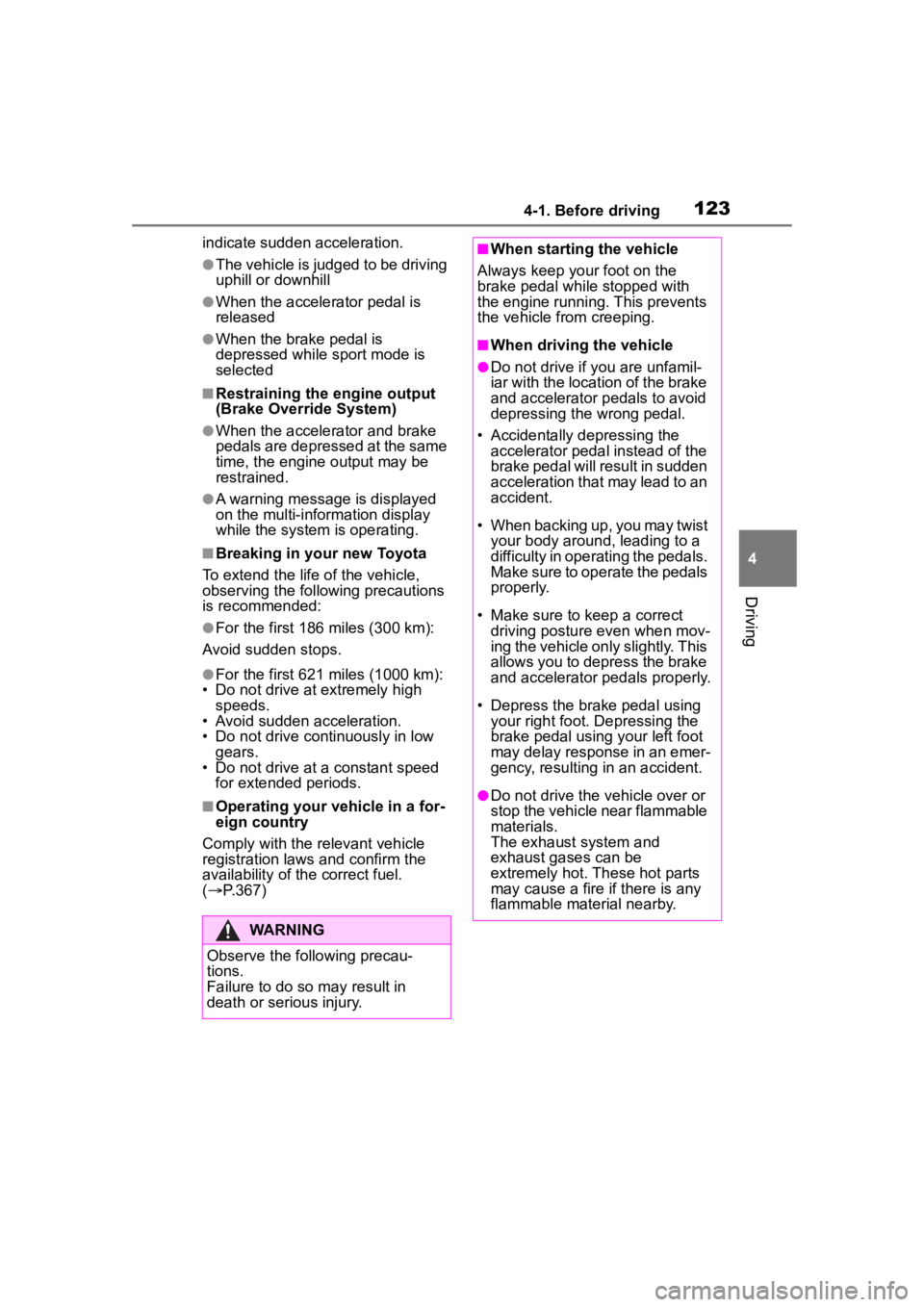
1234-1. Before driving
4
Driving
indicate sudden acceleration.
●The vehicle is judged to be driving
uphill or downhill
●When the accelerator pedal is
released
●When the brake pedal is
depressed while sport mode is
selected
■Restraining the engine output
(Brake Override System)
●When the accelerator and brake
pedals are depressed at the same
time, the engine output may be
restrained.
●A warning message is displayed
on the multi-information display
while the system is operating.
■Breaking in your new Toyota
To extend the life of the vehicle,
observing the following precautions
is recommended:
●For the first 186 miles (300 km):
Avoid sudden stops.
●For the first 621 miles (1000 km):
• Do not drive at extremely high speeds.
• Avoid sudden acceleration.
• Do not drive continuously in low
gears.
• Do not drive at a constant speed
for extended periods.
■Operating your vehicle in a for-
eign country
Comply with the relevant vehicle
registration laws and confirm the
availability of the correct fuel.
( P.367)
WARNING
Observe the following precau-
tions.
Failure to do so m ay result in
death or serious injury.
■When starting the vehicle
Always keep your foot on the
brake pedal while stopped with
the engine running. This prevents
the vehicle from creeping.
■When driving the vehicle
●Do not drive if you are unfamil-
iar with the location of the brake
and accelerator pedals to avoid
depressing the wrong pedal.
• Accidentally depressing the accelerator pedal instead of the
brake pedal will result in sudden
acceleration that may lead to an
accident.
• When backing up, you may twist your body around, leading to a
difficulty in operating the pedals.
Make sure to operate the pedals
properly.
• Make sure to keep a correct driving posture even when mov-
ing the vehicle only slightly. This
allows you to depress the brake
and accelerator pedals properly.
• Depress the brake pedal using your right foot. Depressing the
brake pedal using your left foot
may delay response in an emer-
gency, resulting in an accident.
●Do not drive the vehicle over or
stop the vehicle near flammable
materials.
The exhaust system and
exhaust gases can be
extremely hot. These hot parts
may cause a fire i f there is any
flammable material nearby.
Page 124 of 436
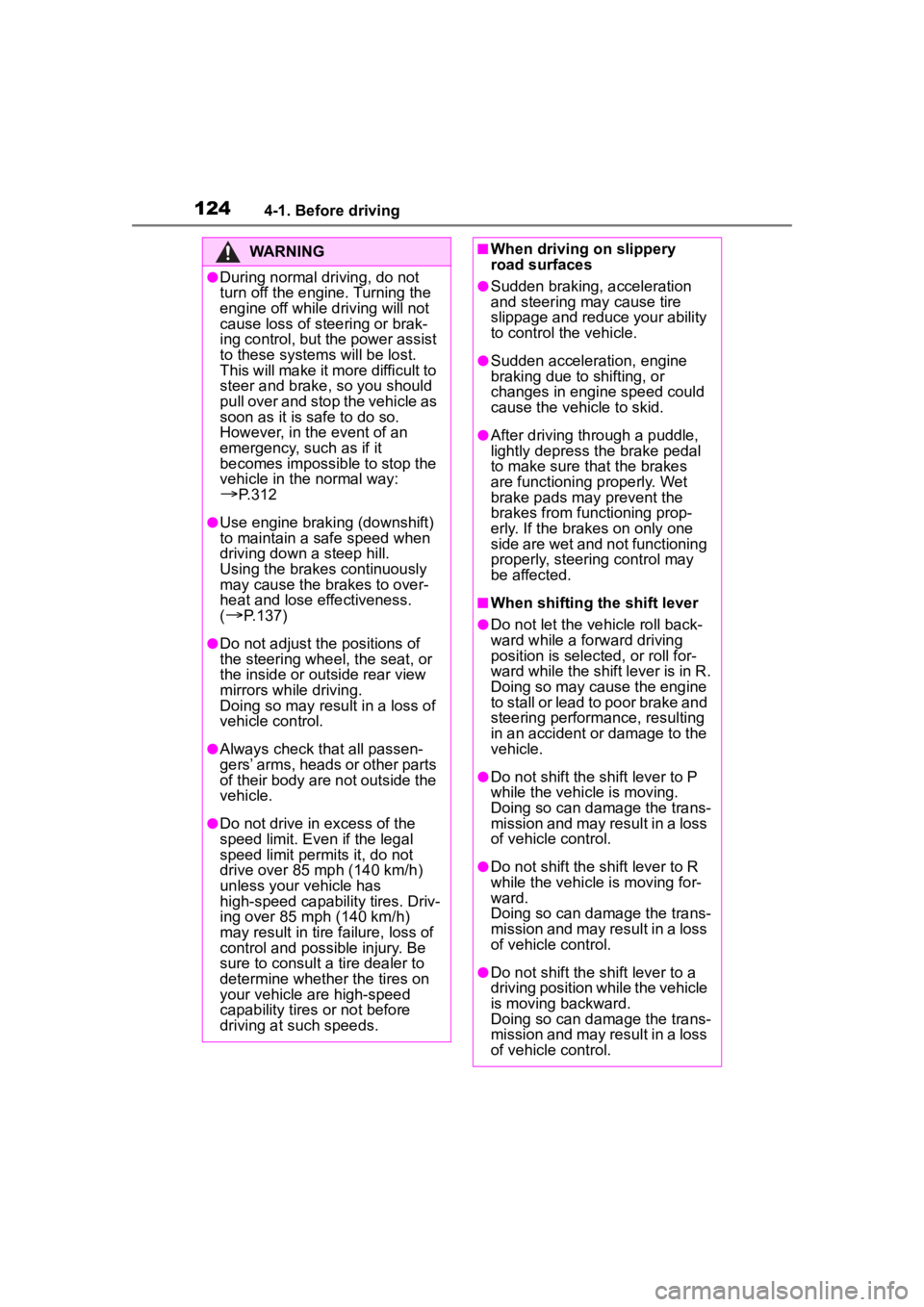
1244-1. Before driving
WARNING
●During normal driving, do not
turn off the engine. Turning the
engine off while driving will not
cause loss of steering or brak-
ing control, but the power assist
to these systems will be lost.
This will make it more difficult to
steer and brake, so you should
pull over and stop the vehicle as
soon as it is safe to do so.
However, in the event of an
emergency, such as if it
becomes impossible to stop the
vehicle in the normal way:
P. 3 1 2
●Use engine braking (downshift)
to maintain a safe speed when
driving down a steep hill.
Using the brakes continuously
may cause the brakes to over-
heat and lose effectiveness.
(
P.137)
●Do not adjust the positions of
the steering wheel, the seat, or
the inside or outside rear view
mirrors while driving.
Doing so may result in a loss of
vehicle control.
●Always check that all passen-
gers’ arms, heads or other parts
of their body are not outside the
vehicle.
●Do not drive in excess of the
speed limit. Even if the legal
speed limit permits it, do not
drive over 85 mph (140 km/h)
unless your vehicle has
high-speed capabilit y tires. Driv-
ing over 85 mp h (140 km/h)
may result in tire failure, loss of
control and possible injury. Be
sure to consult a tire dealer to
determine whether the tires on
your vehicle are high-speed
capability tires or not before
driving at such speeds.
■When driving on slippery
road surfaces
●Sudden braking, acceleration
and steering may cause tire
slippage and reduce your ability
to control the vehicle.
●Sudden acceleration, engine
braking due to shifting, or
changes in engine speed could
cause the vehicle to skid.
●After driving through a puddle,
lightly depress the brake pedal
to make sure that the brakes
are functioning properly. Wet
brake pads may prevent the
brakes from functioning prop-
erly. If the brakes on only one
side are wet and not functioning
properly, steering control may
be affected.
■When shifting the shift lever
●Do not let the vehicle roll back-
ward while a fo rward driving
position is selected, or roll for-
ward while the shift lever is in R.
Doing so may cause the engine
to stall or lead to poor brake and
steering performance, resulting
in an accident or damage to the
vehicle.
●Do not shift the sh ift lever to P
while the vehicle is moving.
Doing so can damage the trans-
mission and may result in a loss
of vehicle control.
●Do not shift the sh ift lever to R
while the vehicle is moving for-
ward.
Doing so can damage the trans-
mission and may result in a loss
of vehicle control.
●Do not shift the shift lever to a
driving position while the vehicle
is moving backward.
Doing so can damage the trans-
mission and may result in a loss
of vehicle control.